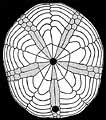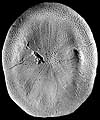The Echinoid Directory
Cubanaster Sanchez Roig, 1952, p. 3
| Diagnostic Features |
|
|---|---|
| Distribution | Middle and Upper Eocene of the Caribbean (Jamaica, Cuba, Panama). |
| Name gender | masculine |
| Type | Jacksonaster torrei Lambert, in Sanchez Roig, 1926, by original designation. |
| Species Included |
|
| Classification and/or Status |
|
| Remarks |
|



